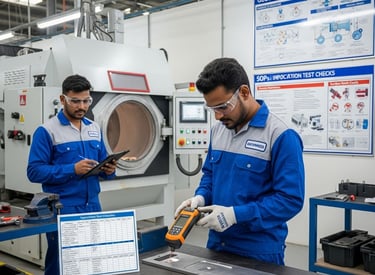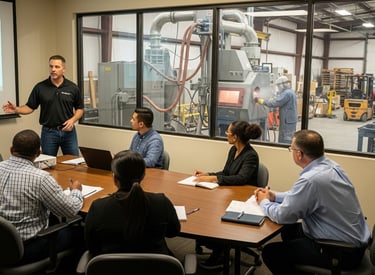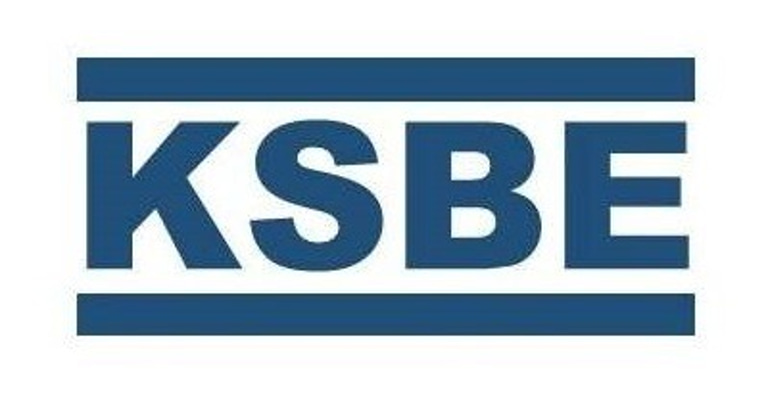Dust, Safety & Compliance
Risk Management in Abrasive Blasting
Expert consulting for air emission, compliance, and sustainable practices in dust generating processes.
FAQs - Understanding Abrasive Blasting
What is sand blasting?
Sand blasting is a generic term historically used to describe the process of cleaning or preparing a surface by propelling sand at high velocity. The term originated when silica sand was the most commonly used abrasive material. Today, the industry prefers the broader term abrasive blasting, which covers the use of various safer, non-silica abrasives.
Is sand blasting banned?
Yes. The use of silica sand in blasting is banned due to the high health risks it poses. Free crystalline silica particles can cause severe respiratory diseases such as silicosis, lung cancer, and other occupational health hazards. For this reason, regulatory authorities prohibit the use of natural silica sand in blasting operations, recommending use of non-silica abrasives.
Then why is it still used?
In modern practice, the term abrasive blasting refers to processes that use safe, non-free-crystalline-silica abrasives such as garnet (non-silica garnet), copper slag, steel grit, aluminum oxide, glass beads, plastic, agro-grit (walnut shell), dry ice, etc. These alternatives eliminate the free crystalline silica hazard while ensuring effective cleaning and surface preparation.
Why is abrasive blasting necessary?
Abrasive blasting is a highly productive and effective surface preparation method for large-scale production, serve critical industrial use cases for cleaning, finishing, roughening, de-burring, etc. The process is mandatory for various infrastructural surface preparation applications. An abrasive blast cleaned surface serve effective bonding of paints and coatings to increase their service life multiple times, ensuring corrosion protection and structure sustainability.
Abrasive Selection and Usage
Unfortunately, some contractors may illegally use silica sand due to lack of awareness, cost-cutting, or untrained labor making compliance awareness critical, putting operator's health at risk. While in some industries and regions, the old term “sand blasting” continues to be used out of habit. Both the cases need proper awareness and monitoring.
What are the safe practices in Abrasive Blasting?
Most manufacturers design enclosed abrasive blasting machines equipped with proper abrasive recycling and dust collection system eliminating the risk of high dust generation and abrasive slippage, and meeting the air emission norms for suspended dust particles. We recommend proper mask, goggles, gloves, PPE for operators. In-situ operators performing abrasive basting inside a blast room, or at infrastructural site in open are recommended to wear Abrasive Blaster's Helmet with filtered air breathing, and PPE.
Types of Abrasive Blasting
The mechanism of propelling abrasives with high velocity and kinetic energy on to a surface defines the type of process.
Air Operated / Pneumatic Blasting: Uses compressed air to propel abrasives out of blasting nozzle through a rubber hose. Facilitate flexible and visible cleaning, easy maneuvering in manual - automatic manner. Can regulate air pressure for soft/thin components. Pneumatic Blasting is further classified as Suction Blasting (syphon feed propelling), Pressure Blasting (Pressurized feed propelling) and Wet Slurry (Slurry feed) methods. Machines are available in varying sizes and features to adjust size of component, with required number of Blast Nozzles, and are fitted with Abrasive Recovery and Dust Collection Systems.
Airless / Centrifugal Wheel Blasting: Propel abrasive with centrifugal wheel. Used for high kinetic energy - high abrasive feed - high production of rigid components - casting, forging, sheets, plates, structures, etc. Machine types are Tumble (batch components) Table type, Hanger type, Tunnel Type (through pass), and available in varying sizes to adjust size of component, required number of Blast Wheels, and are fitted with Abrasive Recovery and Dust Collection Systems.
Safety, Regulations, and Compliances?
Technically, Shot Blasting refers to use of shots - spherical media for abrasive basting. Practically, owing to the risk of self-wear abrasion, balancing and vibration in high RPM centrifugal wheels, the Airless / Centrifugal Wheel Blasting process is recommended to use only shots (not Grit), thus the wheel blasting process is in general termed as Shot Blasting.
Similarly, other blasting processes are termed as Grit Blasting, Glass Bead Blasting, Dry Ice Blasting, and so on.
What is the proper method for surface preparation?
There are various factors to be considered for selecting a right abrasive for any application.
Material: Outdoor Abrasive Blasting on infrastructural sites face recovery and re-use challenge, thus use low cost abrasives like garnet or copper slag having maximum two re-use cycle, while enclosed machines are designed for 50 - 100 recycle reuses of low breaking abrasives like steel grit, steel shots, aluminum oxide, glass beads, etc.
Shape: Sharp multi-edge particles are called Grit, spherical particles are called Shot.
Size: All abrasive are available in their grade - mesh number, in respective (ASTM/ISO) international and (IS) national standards for particle size classification.
Selection of abrasive type depends on the required surface finish and application served. Selection of its particle size range depends on surface roughness to be created for the needed application. Selection of abrasive material, particle size, type of blasting process, operating parameters, and the roughness created needs proper R&D trials, inspections, and process set up by experts, or as recommended by principal.
What is Shot Blasting?
Eliminating the use of Silica Sand Blasting as a banned process, all other forms of abrasive blasting media, machines and processes are a vital part of progressive industrial surface treatment requirements, used for component finish, safety, longevity, refurbishment, reuse, contributing in service life, circular economy, sustainability, and are safe to use under required compliances:
SPM Dust emission is to be under specified air emission limits
Noise - from Dust Collector Fan Blower, Compressor - or process to be within industry standards.
Waste Disposal - of used abrasives and metal dust to be controlled as per industry standards
Liquid discharge (only for slurry blasting) is to be monitored or disposed after drying as dry waste.
Chemical and Other Non-Hazardous Wastes - Not Applicable
Occupations Health and Safety - of operators to be monitored by providing proper PPE, awareness, and guidelines.
For Open Blasting at Infrastructural / Fabrication Sites or Structural Repair Maintenance Works - additional provisions are to be made by contractors for Dust Suppression - Dust Collection, Abrasive Recovery, Slippage Prevention, Waste Disposal, and for Operators PPE.
What is the solution for safe processes?
The solution lies in adopting:
Regulatory Compliance – adhering to Pollution Control Board standards, permissible emission limits, and occupational safety regulations.
Engineering Controls – avoid open blasting, use proper design machines with abrasive recycling, dust collectors, and ensure proper local area ventilation.
Safer Practices – using approved non-silica abrasives, protective equipment, and trained operators.
Machine Maintenance and Servicing - ensure better operating conditions, filter cleaning, choking, waste disposal, machine wear and abrasion, spare parts, and operation and usage training.
Consulting and Guidance – engaging expert advisory services like KSBE to design compliant blasting systems, adopt alternative abrasives, and implement best practices.
Why Compliance Matters
Addressing safety and environmental impacts of abrasive blasting and dust generation processes in abrasive blasting


Environmental Effects
High risks from abrasive blasting and untrained labor handling processes.
Regulations & Guidelines
National and international compliance standards for abrasive blasting activities.
Consulting Services
Solutions offered by KSBE for compliance with safety and environmental regulations.
Our Services
At KSBE, we deliver actionable, results-driven consulting and industrial services that help manufacturers enhance performance, reduce operational waste, and achieve sustainable growth. Our decades of on-ground manufacturing experience, combined with strategic foresight, allow us to address both current industrial challenges and future readiness without overcomplicating the journey. Led by decades of industrial fieldwork, KSBE helps industries scale quality, efficiency, and sustainability globally.
We focus on two essential service domains that enable our clients to remain competitive, compliant, and future-aligned.
Inspection, Testing and Support Services
Equipment Health Checkup, Servicing, AMC,
Quality & Performance Benchmarking
Inspection and Test Standards, SOPs
Adopt Global Practices and Standards
Operator's Training and Development
Inspections, Audits, and Certifications,


Process Engineering & Optimization Advisory
Equipment & Process Selection
Optimize Operational Parameters, SOP
Process Costing, Economics, & ROI Analysis
Machine, Spares, Consumable Standards
Preventive and Predictive Analysis
Equipment Modernization, Refurbishment


Why Compliance Matters
Addressing safety and environmental impacts of abrasive blasting and dust generation processes.


Environmental Effects
High risks from abrasive blasting and untrained labor handling processes.
Regulations & Guidelines
National and international compliance standards for abrasive blasting activities.
Consulting Services
Solutions offered by KSBE for compliance with safety and environmental regulations.
Eco-Friendly Solutions
Guiding industries towards sustainable practices for a greener future.


Pollution Control
Expert guidance on managing dust and fumes effectively.
Waste Management
Strategies for minimizing waste and promoting recycling initiatives.
Safety Compliance
Ensuring reliable operations while adhering to environmental regulations.
Dust Control Solutions
Expert consulting for dust control and air emission solutions.


Consulting Services
Pre-feasibility analysis and environmental impact assessments.


Compliance Standards
International and national pollution control measures.




Health & Safety
Occupational health and safety best practices.
Sustainability Goals
Meeting global sustainability requirements and standards.
→
→
→
→
Sustainability Services
Comprehensive solutions for environmental compliance and sustainability training.


Air Emission Control
Ensure compliance with air emission and dust control regulations effectively.
Safety Management
Manage process hazards and enhance safety protocols in your operations.
Waste Management
Implement waste management strategies for a circular economy and resource efficiency.
Our Projects
Explore our diverse case studies in dust control.


Abrasive Blasting
Effective solutions for dust management in blasting.


Mineral Processing
Specialized dust control for mineral processing operations.




Sawdust Collection
Centralized system for efficient sawdust management.
EIA Consultation
Comprehensive environmental compliance and assessment services.
→
→
→
→
Sustainability Consulting
Partnering to reduce environmental impact and align with global standards.


Management Systems
Expertise in optimizing management systems for sustainability.
Environmental Processes
Enhancing environmental processes for responsible industry practices.
Manufacturing Solutions
Integrating efficient manufacturing solutions to extend product life.
Consulting Services
Expert guidance on compliance, sustainability, and safety standards for various industries.


Regulatory Compliance
Helping organizations meet regulatory requirements and standards effectively.
Management System Certification
Assisting in achieving certifications for quality and environmental management systems.
Feasibility Assessments
Conducting thorough assessments for impact and compliance with regulations.
Contact Us


Reach out for expert consulting on dust control and environmental compliance solutions.


Gallery
Explore our solutions for dust control and emissions.




Subscribe for Dust Control Insights
Stay updated on air emission solutions.
Client Feedback
Outstanding services for dust control and compliance.
Their pre-feasibility analysis was thorough and impressive.
John Doe
New York
ksbe's expertise in air emission control made a significant difference in our operations.
Jane Smith
San Francisco
★★★★★
★★★★★
KSBE - DTX
Trustworthy
What's Latestin Technology & Solutions
info@ksbe.in
+91 9414914586
© 2025. All rights reserved.
Works: Pali, Rajasthan
Quality
Office: Okhla, Delhi
